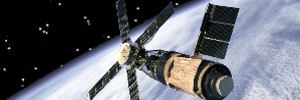Japanese Rockets Overview
Over the years, several agencies have been responsible for development and operation of Japanese space launchers. The ISAS (Institute of Space and Astronautical Sciences) was largely responsible for the Lambda and Mu series of rockets. Another agency, known as NASDA (National Space Development Agency), managed the N-1, N-2, and H series of rockets. On 1 October 2003, ISAS, NASDA, and the NAL (National Aerospace Laboratory of Japan), were combined to form JAXA (Japan Aerospace EXploration Agency). JAXA now oversees all Japanese launch vehicles.
Lambda Rockets
Based on sounding rocket technology, Lambda was a series of increasingly capable, solid fueled rockets.
The Lambda L-1 was a single stage sounding rocket. The L-2 added a second stage. The L-3 model had three stages. The final version, known as L-4, had four stages and was the first Japanese rocket to orbit a satellite.

L-4S
On 11 February 1970, a Lambda L-4S rocket launched Japan's first orbital satellite. Four previous attempts failed.
The L-4S was a four stage rocket. All stages used solid propellant.
Mu Series of Rockets
The Mu series of rockets were developed for placing scientific satellites into orbit.
Versions included the M-4S, M-3C, M-3H, M-3S, M-3S11, and the M-V.

M-3-SII
First flown in 1985, the M-3S11 could place a 770 kg payload into low Earth orbit. M-3S11 rockets launched a number of important scientific payloads, including Japan's first two interplanetary probes. Sakigake and Suisei, launched separately in 1985, performed flybys of Halley's comet.
Eight missions were flown, with one failure and seven successful launches.
 M-3-SII Stages
M-3-SII Stages
M-3-SII Flights
M-3-SII-1 Launched the Sakigake probe to Halley's Comet on 8 January 1985.
M-3-SII-2 Launched the Suisei (PLANET-A) probe to Halley's Comet on 19 August 1985.
M-3-SII-3 Launched the Ginga (ASTRO-C) X-ray astronomy satellite on 5 February 1987.
M-3-SII-4 Launched Akebono (EXOS-D) on 22 February 1989.
M-3-SII-5 Launched the Lunar fly-by mission, Hiten (MUSES-A), on 24 January 1990.
M-3-SII-6 Launched the Yohkoh (SOLAR-A) solar observatory on 30 August 1991.
M-3-SII-7 Launched the Asca (ASTRO-D) x-ray astronomy mission on 20 February 1993.
M-3-SII-8 Launched on 15 January 1995, failed to place its payload, the Express satellite, in the correct orbit.

M-V
The M-V rocket, first flown in 1997, was the final model of the Mu rocket series. The solid fueled rocket measured 30.8 meters tall and 2.5 meters in diameter.
The M-V rocket was used primarily for scientific missions, including several astronomy satellites and an asteroid exploration mission. Of the seven rockets launched, six were successes. The failed launch, M-V-4, was believed to have been caused by an engine nozzle problem.
 M-V Stages
M-V Stages(Configuration for Hyabusa Launch)
M-V Flights
M-V-1 Launched the Halca (Muses-B) radio astronomy satellite on 12 February 1997.
M-V-3 Launched the Nozomi (Planet-B) radio astronomy satellite on 4 July 1998.
M-V-4 Suffered a launch failure on 10 February 2000. The payload was the Suzaku (Astro-E) x-ray astronomy satellite
M-V-5 Launched the Hayabusa (Muses-C) asteroid mission on 9 May 2003.
M-V-6 Launched the Suzaku (Astro-EII) x-ray astronomy satellite on 10 July 2005.
M-V-7 Launched the Hinode (Solar-B) solar observatory on 23 September 2006.
M-V-8 Launched the Akari (Astro-F) infrared observatory on 22 February 2006.
Delta Derived Rockets
Starting in the 1970's, Japan built several rockets utilizing technology from the American Thor-Delta series of rockets.

N-1
The N-1 rocket, first flown in 1975, used technology from the American Thor-Delta series of rockets. The three stage rocket was 32.57 meters tall.
Seven missions were flown between 1975 and 1982. Payloads included several engineering test satellites and experimental communications satellites.

N-2
The N-2 rocket, first flown in 1981, used technology from the American Thor-Delta series of rockets. The three stage rocket was 35.36 meters tall.
Eight missions were flown between 1981 and 1987. Payloads included an engineering test satellite, two experimental communications satellites, two geostationary meteorological satellites, two broadcasting satellites, and a Marine observation satellite.

H-1
The H-1 rocket first stage was a license-built version of an American Delta rocket first stage. The upper stages were of Japanese design.
The H-1 first flew on 13 August 1986. A total of nine rockets were launched. The final liftoff occurred on 11 February 1992.
H-2 Series of Rockets

H-2
The Japanese developed H-2 rocket featured a significantly higher payload then the Delta-derived H-1. The H-2 was first flown on 4 February 1994.
The four meter in diameter H-2 first stage was powered by the newly developed LE-7 rocket engine. The high performance LE-7 was fueled with liquid hydrogen and liquid oxygen. A pair of large solid rocket boosters supplemented the first stage thrust.
The second stage uses a restartable engine known as the LE-5A. The liquid hydrogen and liquid oxygen fueled LE-5A was an improved version of the LE-5 first used in the H-1 second stage.
Seven launch attempts were made. One rocket had to be destroyed when the vehicle failed to follow the proper course.


H-2A
The H-2A rocket was developed as a simpler, more reliable, version of the H-2.
The H-2A uses a new type of SRB known as an SRB-A. Each SRB-A measures 15 meters in length and 2.5 meters in diameter. The standard H-2A configuration uses two SRB-A boosters.
By adding two additional SRB-A boosters, or up to four smaller solid rocket boosters, the H-2A rocket can be configured for different payload sizes and orbits.
The H-2A was first flown on 29 August 2001. The rocket is still in service.
An H-2A-2022 (illustration at right), with two SRB-A boosters and two smaller solid rocket boosters, launched the SELENE (Kaguya) lunar orbiter probe in 2007.

H-2B
The H-2B rocket uses a larger first stage then the standard H-2A. In addition to significantly larger fuel capacity, the first stage uses two LE-7A main engines, one more then on the H-2A. The first stage is surrounded by four SRB-A solid rocket boosters.
The primary payload for the H-2B is the Japanese HTV spacecraft. The HTV (H-2 Transfer Vehicle) is designed to carry cargo to the International Space Station. The first HTV was launched on 10 September 2009. After several weeks at the station, the HTV separated and re-entered Earths atmosphere.
The HTV is around 10 meters long and can transport both pressurized and unpressurized cargo. Additional HTVs are scheduled to resupply the space station about once per year.
Epsilon Rocket

Epsilon
The Japanese Epsilon rocket was developed as a lower cost launcher for small payloads. The rocket is comprised of three solid-fueled stages and an optional liquid fueled fourth stage. The first Epsilon rocket was launched on 14 September 2013 JST. The launch occurred at the Uchinouora Space Center and placed the SPRINT-A spacecraft into Earth orbit.
 Epsilon Rocket Stages
Epsilon Rocket Stages
First Stage
First stage is an SRB-A solid rocket motor. The SRB-A is also used as strap-on boosters for the H-2A and H-2B rockets.
Second Stage
Second stage is an M-34c motor.
Third Stage
A KM-V2b motor serves as third stage.
Fourth Stage
A compact liquid propulsion system (CLPS) is available as an optional configuration.









 Images by Richard Kruse are licensed under a Creative Commons Attribution-Noncommercial 3.0 United States License.
Images by Richard Kruse are licensed under a Creative Commons Attribution-Noncommercial 3.0 United States License.